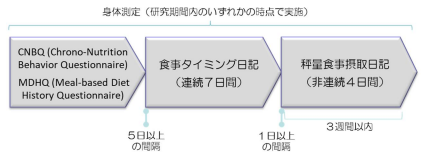2025-05-13 東京大学

<関連情報>
- https://www.u-tokyo.ac.jp/content/400263894.pdf
- https://nutritionj.biomedcentral.com/articles/10.1186/s12937-025-01129-1
食事の質と肥満に関連するクロノニュートリション行動:食事評価法とエネルギー摂取量の誤報告は問題か? Chrononutrition behaviors in relation to diet quality and obesity: do dietary assessment methods and energy intake misreporting matter?
Kentaro Murakami,Nana Shinozaki,M. Barbara E. Livingstone,Tracy A. McCaffrey,Shizuko Masayasu & Satoshi Sasaki
Nutrition Journal Published:28 April 2025
DOI:https://doi.org/10.1186/s12937-025-01129-1
Abstract
Background
Inconsistent epidemiologic findings on the associations of chrononutrition behaviors with diet quality and adiposity measures may be due to the use of different dietary assessment methodologies and a lack of consideration of dietary misreporting. We aimed to investigate the associations by using questionnaires and diaries, with adjustment for energy intake (EI) misreporting.
Methods
This cross-sectional study included 1047 Japanese adults aged 20–69 years. We used the Chrono-Nutrition Behavior Questionnaire (CNBQ) or 11-day diaries to assess chrononutrition behaviors (meal frequency, snack frequency, total eating frequency, timing of first eating occasion, timing of last eating occasion, duration of eating window, and eating midpoint) for workdays and non-workdays separately. Eating jetlag was defined as the eating midpoint difference between workdays and non-workdays. Diet quality was assessed using the Healthy Eating Index-2020, based on the Meal-based Diet History Questionnaire (MDHQ) or 4-day weighed food diaries. EI misreporting was evaluated using the Goldberg cut-off principle.
Results
Using questionnaire data (CNBQ and MDHQ), we found inverse associations of snack and total eating frequencies, timing of last eating occasion, eating midpoint, and eating jetlag with diet quality (P < 0.05), irrespective of adjustment for EI misreporting. Also, we found positive associations of meal, snack, and total eating frequencies and duration of eating window with the prevalence of general obesity (body mass index ≥ 25 kg/m2), abdominal obesity (waist circumference ≥ 90 cm for males; ≥ 80 cm for females), or both; many of these associations were only evident (P < 0.05) after adjustment for EI misreporting. In contrast, using diary data, we found no associations between chrononutrition behaviors and diet quality, general obesity, or abdominal obesity, regardless of adjustment for EI misreporting (except for inverse associations of timings of first and last eating occasions and eating midpoint on workdays with diet quality).
Conclusions
The associations of chrononutrition behaviors with diet quality and obesity were dependent on the methodology used to assess these behaviors. Adjustment for EI misreporting radically changed only the associations with obesity in the questionnaire-based analysis. These findings suggest the importance of careful consideration of dietary assessment method selection and EI misreporting in chrononutrition research.


